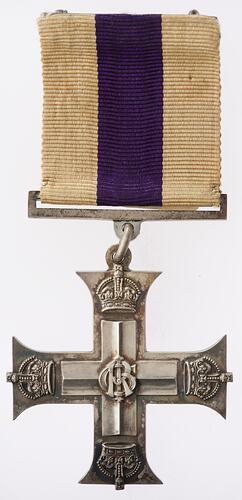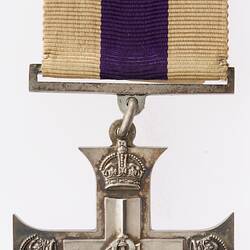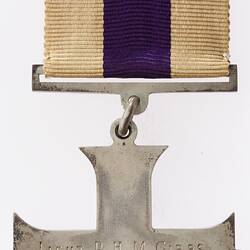Summary
Military Cross, George V, issued around 1917. Stored in its original black case, with a gilt-embossed crown on the top and lined with yellow/cream velvet. This gallantry decoration was instituted on 31 December 1914 for captains, lieutenants and warrant officers in the Army (extended to majors in 1931 and to all ranks in 1993).
The back of the cross is engraved 'Lieut. R. H. M. Gibbs, 59th Battalion, A.I.F.' A laminated photograph of Lieutenant Gibbs and an undated newspaper cutting are stored in the case.
At the time of his enlistment on 10 May 1915 to serve in World War I, Richard Horace Maconochie Gibbs - 'Mac' - was training to be a doctor at the University of Melbourne, and had completed three years of medical training. He was also a member of the University VFL team. Mac was placed in the 6th Battalion, 14th Reinforcements, and left Australia in February 1916. He spent time in Egypt before travelling to France in June 1916, the same month that he was gazetted as a lieutenant. On 19 July 1916 he was reported missing in the trenches of Fleurbaix, France, during the Battle of the Somme; his Military Cross for bravery was awarded two months later, in August that year. It was not until August 1917 that a Court of Inquiry officially listed him as killed in action, with the date of death stated as the day he went missing. His body was never found.
Mac's brother John Harbinger Gibbs - 'Jack' - also served in World War I, notably as a sniper in Gallipoli. He returned to Australia in July 1917 suffering tuberculosis and passed away on 13 October that year, aged 20. After the deaths of John and Richard, their father Dr Richard Horace Gibbs gave up his medical practice in Colac and devoted himself to caring for sick and wounded soldiers who had returned to Australia. Richard and his wife Helen moved to 5 Normanby Avenue, Caulfield, in 1919, the same street in which Albert Kemp, another soldier killed in World War I who is remembered at Museum Victoria, had lived. Tragedy struck the family again when Dr Gibbs died after a fall from a tram in July 1919.
Mac and Jack's younger brother, Angus Martin (1902-1985), preserved Richard's medal throughout his long life, and in his final years donated it to the RSL, which in turn donated it to Museum Victoria.
Physical Description
Silver cross with arms terminating in broad finials decorated with imperial crowns suspended by a loop to a plain suspension bar and white ribbon with broad central purple stripe with silver bar decorated with imperial crown. At the centre of the cross, the Royal cypher GRI (George King and Emperor). The reverse is engraved Lieut. R. H. M. Gibbs, 59th Battalion, A.I.F.
Obverse Description
Silver cross with arms terminating in broad finials decorated with imperial crowns suspended by a loop to a plain suspension bar and white ribbon with broad central purple stripe with silver bar decorated with imperial crown. At the centre of the cross, the Royal cypher GRI (George King and Emperor).
Reverse Description
Engraved LIEUT. R. H. M. GIBBS. / 59th Ball'n A.I.F.
Edge Description
Plain
More Information
-
Collection Names
Returned and Services League (RSL) Collection, Military Memorabilia Collection
-
Collecting Areas
-
Acquisition Information
Donation from Victorian Branch, Returned & Services League of Australia Limited (RSL), 24 Feb 1986
-
Date Issued
circa 1917 AD
-
Awarded To
Lieutenant Richard H. Gibbs - Australian Imperial Force (AIF), Australia, circa 1917
-
Issued By
-
Inscriptions
Lieut. R. H. M. Gibbs, 59th Battalion, A.I.F.
-
Material
Silver
-
Axis
12
-
Classification
-
Category
-
Discipline
-
Type of item
-
Overall Dimensions
44 mm (Width), 10 mm (Depth), 92 mm (Height)
-
Shape
Cross with ribbon
-
References
Studio portrait of 1951 Private (Pte) John Harbinger Gibbs, P07241.003, Australian War Memorial, [Link 1] accessed 17 Dec 2013.
-
Keywords
Militaria: Australian, World War I, 1914-1918, Battle of the Somme (Somme Offensive), 1916




